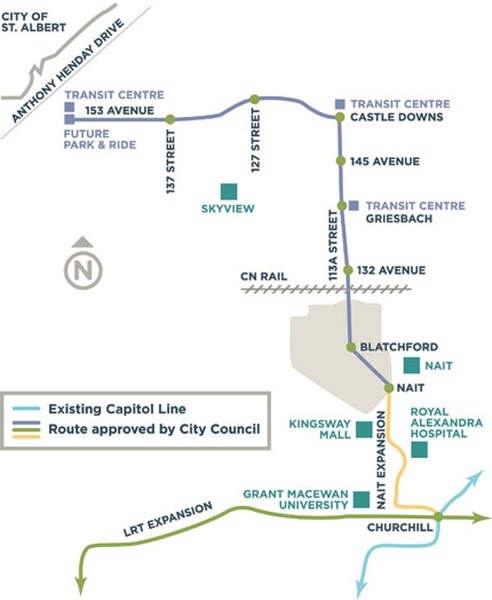St. Albert could be waiting another decade or two for light rail transit (LRT).
The announcement of a new hospital in the south of Edmonton has rekindled the debate over what part of the city should receive LRT next.
Though Edmonton council currently has only two approved priorities – the west leg and the extension of the Metro Line from NAIT to Blatchford – the understanding was that Edmonton’s north, which currently does not have access to LRT, would be next in line.
If Edmonton council prioritizes the Capital Line extension, from Century Park to Ellerslie, over the north extension from Blatchford to the future Campbell Park and Ride, St. Albert could be waiting up to 20 or 30 years for LRT access. The north/south discussion had led to a fierce debate among Edmonton councillors, but it’s not a debate St. Albert’s mayor will be involved in at this time.
“Edmonton has to make their own decisions based on their own money, their own politics, their own information,” said Mayor Nolan Crouse. “Would I like to see St. Albert highest in the priority list? Of course I would. That’s a very selfish view, when I realize they have a lot of competing issues.”
The case for expanding south is a strong one. Not only will the area be getting a new state of the art health-care facility, which will be located adjacent to the planned Ellerslie Park and Ride, but it boasts the highest population growth in the city.
The lease for Capital Line’s southernmost and most heavily used park and ride, Century Park, also expires in 2020. Though there are plans to build a new temporary facility further south, it requires commuters to board a shuttle for four kilometres before accessing the LRT system at Century Park.
Tuesday’s executive committee meeting in Edmonton sparked a discussion about the possibility of bus rapid transit (BRT) to temporarily serve those living in the north of Edmonton.
From an infrastructure standpoint, the new Campbell station would be able to accommodate BRT, said Kevin Bamber, director of Transit St. Albert. The park and ride facility is intended to act as both a future LRT station and a major bus hub and the site allows for the structure to grow as needed.
But again it’s up to Edmonton council to decide whether they wish to operate BRT from the station.
Though St. Albert Transit works closely with its Edmonton counterpart, operating BRT would require the involvement of several other departments, in order to adjust signal timing or create additional lanes, said Bamber.
“I’m not sure the other departments would accommodate what St. Albert needs to run BRT,” he said.
While Guy Boston, branch manager of LRT delivery and former executive director of economic development at the City of St. Albert, told media outlets that BRT before LRT was an interesting option the city would keep in mind, both systems require the construction of a bridge over the CN Rail land and the Yellowhead Trail. The bridge is estimated to cost between $100 million to $200 million.
Crouse said advocating for BRT as a temporary measure may be something the next council wants to look into.
“This won’t be something this council will spend any time on,” said Crouse.
Plans to build the Campbell station and form a transit commission won’t be affected by Edmonton’s timelines.
Edmonton council will decide on LRT priorities in the fall.



